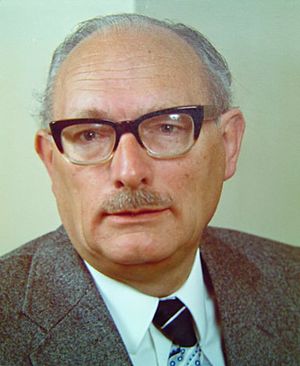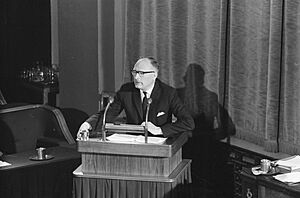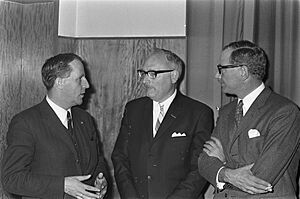Johan van Hulst facts for kids
Quick facts for kids
Johan van Hulst
|
|
|---|---|

Van Hulst in 1980
|
|
| Leader of the Christian Democratic Appeal in the Senate | |
| In office 8 June 1977 – 10 June 1981 |
|
| Preceded by | Office established |
| Succeeded by | Jan Christiaanse |
| Leader of the Christian Historical Union in the Senate | |
| In office 10 December 1968 – 8 June 1977 |
|
| Preceded by | J. C. Bührmann |
| Succeeded by | Office abolished |
| Chair of the Christian Historical Union | |
| In office 5 October 1968 – 19 February 1972 |
|
| Leader | Jur Mellema (1968–1970) Berend Jan Udink (1970–1971) Arnold Tilanus (1971–1972) |
| Preceded by | Arnold Tilanus |
| Succeeded by | Otto van Verschuer |
| Senator of the Netherlands | |
| In office 3 July 1956 – 10 June 1981 |
|
| Member of the European Parliament | |
| In office 16 October 1961 – 30 September 1968 |
|
| Constituency | Netherlands |
| Personal details | |
| Born |
Johan Willem van Hulst
28 January 1911 Amsterdam, Netherlands |
| Died | 22 March 2018 (aged 107) Amsterdam, Netherlands |
| Political party | Christian Democratic Appeal (from 1980) |
| Other political affiliations |
Christian Historical Union (1945–1980) |
| Spouse | Anna Jannetta Donker (m. 1936–1998; her death) |
| Children | 4 children |
| Residences | Amsterdam, Netherlands |
| Alma mater | Vrije Universiteit Amsterdam (MPhil, PsyM, EdM, MLitt, PhD, PsyD, EdD and DLitt) |
| Occupation | Politician, author, teacher, pedagogue, professor |
Johan Willem van Hulst (born January 28, 1911 – died March 22, 2018) was a Dutch school director, university professor, and politician. He is most famous for his brave actions during World War II. In 1943, he helped save over 600 Jewish children from being sent to concentration camps.
For his heroic efforts, he received the Righteous Among the Nations award from Israel in 1973. This award honors non-Jews who risked their lives to save Jews during the Holocaust.
Van Hulst also had a long career in politics. He served as a Senator in the Netherlands from 1956 to 1981. He was a leader for two political parties: the Christian Historical Union (CHU) and later the Christian Democratic Appeal (CDA). He was also a Member of the European Parliament (MEP).
Contents
Early Life and Education
Johan Willem van Hulst was born in Amsterdam, Netherlands, on January 28, 1911. His parents were Gerrit van Hulst and Geertruida Hofman.
He studied psychology and pedagogy at the Vrije Universiteit Amsterdam. Pedagogy is the study of how to teach.
Before becoming a professor, he worked as a teacher and mentor. He taught in several Dutch towns like Oudewater, Utrecht, and Purmerend.
Saving Jewish Children During World War II
In 1942, Van Hulst was the director of a teacher training college in Amsterdam. His college was located at Plantage Middenlaan 27.
Right across the street, at Plantage Middenlaan 24, was the Hollandsche Schouwburg theatre. This theatre was used by the Nazis as a collection point for Jewish people in Amsterdam. From here, Jewish families were sent to concentration camps.
Children who arrived at the theatre were separated from their parents. They were sent to a nearby nursery at Plantage Middenlaan 31. This nursery was run by Henriëtte Pimentel.
The nursery shared a back garden with Van Hulst's college. This shared garden became very important for the rescue efforts.
The Rescue Operation
Starting in January 1943, Van Hulst, Henriëtte Pimentel, and Walter Süskind worked together. Süskind was a German Jew who the Nazis had put in charge of the Hollandsche Schouwburg.
They secretly looked for families who could adopt the Jewish children. These families needed children who would blend in without being noticed. Once the children's parents agreed, their names were removed from the Nazi's lists. This made it seem like the children were never there.
Van Hulst and his helpers would move the children from the nursery. They would sneak them over the hedge that separated the nursery's garden from the college's garden. Students from the college or local university students often helped.
To get the children away from the school, they were hidden in various ways. They were put into bags, sacks, or even laundry baskets.
Clever Escape Methods
Many clever methods were used to move the hidden children. One common trick involved waiting for a tram to pass by. The tram would block the view of the Nazi guards at the Hollandsche Schouwburg.
As soon as the tram blocked the view, helpers would quickly cycle away. They carried the hidden child with them, often in a bag or basket.
The rescue operation continued until September 29, 1943. On that day, the Nazis sent Henriëtte Pimentel and 100 children from the nursery to concentration camps.
Decades later, Van Hulst spoke about that terrible day. He said it was the hardest day of his life. He had to choose which children to save, knowing the others would likely die. He managed to save 12 children that day. He later wondered why he didn't try to save 13. He believed saving too many at once would have made the Nazis suspicious.
In total, this amazing operation saved between 500 and 1,000 Jewish babies and children.
Recognition and Legacy
Van Hulst received the Yad Vashem award in 1973. This award is given to non-Jewish people who helped save Jews during the Holocaust.
In 2012, Israeli Prime Minister Benjamin Netanyahu visited the Netherlands. He met Van Hulst and thanked him. Netanyahu said, "You saved hundreds of universes." Van Hulst humbly replied, "I only can hope the angels may conduct them into paradise," referring to the children he could not save.
In 2016, Van Hulst's former teacher training college became the Dutch National Holocaust Museum. This museum helps people remember the history of the Holocaust.
Shortly before his 107th birthday in 2018, Van Hulst shared his war experiences on Dutch television. He passed away on March 22, 2018, at the age of 107.
After his death, a bridge in Amsterdam was named the Johan van Hulstbrug in his honor. It is located near the school where he saved so many lives.
Political Career
Johan Willem van Hulst was a member of the Senate of the Netherlands for many years. He served from 1956 to 1981. The Senate is like an upper house of parliament, where laws are reviewed.
From 1961 to 1968, he was also a Member of the European Parliament (MEP). This meant he helped make decisions for countries in Europe.
Party Leadership
Van Hulst became the Chairman of the Christian Historical Union (CHU) on October 5, 1968. As chairman, he led the party.
He was responsible for preparing the party for the general election in 1971.
From 1972 to 1981, Van Hulst was a group leader in the Senate. First, he led the CHU group. Then, from 1977, he led the Christian Democratic Appeal (CDA) group. The CDA was formed when several Christian parties, including the CHU, merged.
Personal Life and Hobbies
Van Hulst was also a very good chess player. In 2006, when he was 95 years old, he won the Corus Chess Tournament for former politicians. He won it again in 2010, showing his sharp mind even at an old age.
He was the first former member of the Dutch Senate to live to be 100 years old. The Senate was established in 1815.
After Van Hulst passed away at 107, many people honored him. The U.S. Ambassador to the Netherlands, Pete Hoekstra, said Van Hulst was "truly an inspiration." The Senate of the Netherlands also held a special meeting to remember him.



